antiatlas journal #3
Boundary works: Art, science, technology
Jean-Paul Fourmentraux
A virtual actor, a crossmedia circus and interactive images ... In the new laboratories of art and computer research-creation (Ircam, Hexagram, Cnam), hybrid works make irreversible the division of the ancient borders setting art and science. By emphasizing the arrangements necessary for finishing a co-production whose social career is described, this article draws attention to the changes introduced through digitalized innovations and explains the new arrangements for giving credits and promoting partnerships between art, science and technology
Jean-Paul Fourmentraux, Socio-anthropologist and Art critic is Professor at the University of Aix-Marseille - Research Director (HDR Sorbonne) at the Ecole des Hautes Etudes en Sciences Sociales (EHESS) at the Norbert Elias Center (UMR- CNRS 8562) - Member of the Art-Science-Society program of the Mediterranean Institute for Advanced Studies (IMéRA, RFIEA). His interdisciplinary research (Sociology, Aesthetics, Communication) focuses on the relationships between contemporary arts, sciences and digital humanities.
He has published Art et internet (CNRS, 2005, 2010), Artistes de laboratoire (Hermann, 2011), L’œuvre commune (Presses du réel, 2012), L’Œuvre virale (La Lettre Volée, 2013) et a dirigé les ouvrages L’Ere Post-media (Hermann, 2012), Art et Science (CNRS, 2012), Identités numériques (CNRS, 2015), Digital Stories (Hermann, 2016) Images interactives (La Lettre Volée, 2017). See http://www.linkedin.com/in/jeanpaulfourmentraux
Keywords: research-creation, attribution, distributed author, artistic creation, interdisciplinarity, frontier works, technological research, promotion
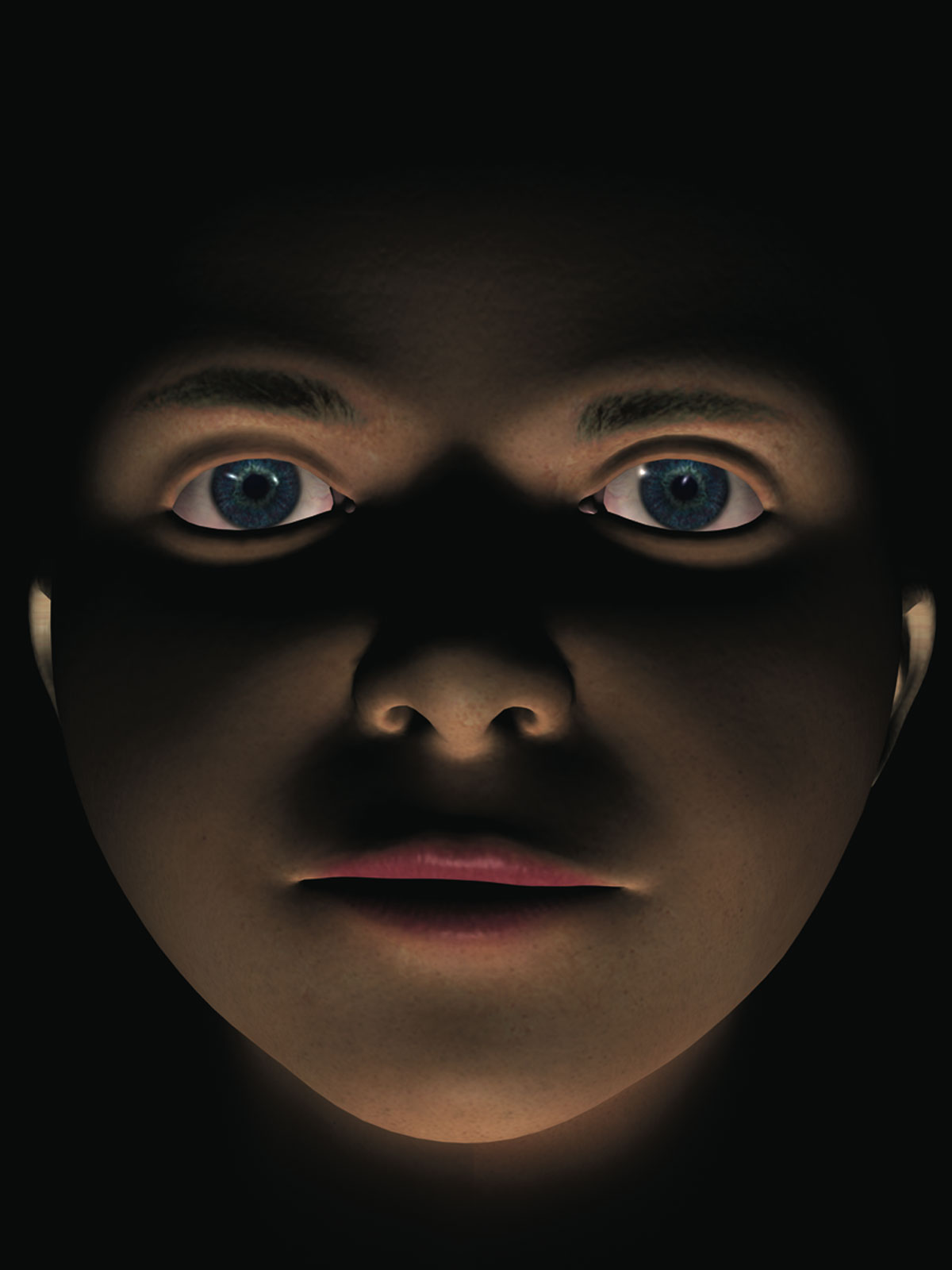
Picture © Roland Auzet, Schlag !, 2003-2017
To quote this article : Fourmentraux, Jean-Paul, "Boundary Works: Art, Science, Technology" published on December 4th, 2019, antiAtlas Journal #3 | 2019, online, URL : https://www.antiatlas-journal.net/03-boundary-works-art-science-technology, last consultation on Date
1He looks like the little boy from Volker Schlöndorff’s Tin Drum, the child who refuses to grow up and shouts his pain for the whole world to hear. What is unusual about him is that he is a virtual being created by Catherine Ikam and Louis Fléri in collaboration with both the Institut Image at Chalon-sur-Saône and the Darwin Agency, which forms part of the University of Montreal. Every night, from 10 to 22 June 2003, he starred as the main character in Schlag!, a show created by musician Roland Auzet. In Schlag!, Oscar appears on three screens opposite six circus performers and three percussionists, projecting his moods onto the troupe thanks to software developed for this purpose.
Schlag! is the title of a complex “multimedia circus” project involving musicians, circus performers, and dancers in a production whose main actor, Oscar, is a virtual character. Oscar’s presence involves and yields some creative interdisciplinary work at the intersection of traditional arts (circus tricks, the composition of a percussion ensemble) and technological innovation (sound processing in real-time, as well as synthetic images and interactive devices designed to capture the actors’ movements on video).
Following recent academic work, according to which art or science should be considered from the perspective of their collective, uncertain, and prototypical production, I would like to examine the ways in which a “boundary work”, which is understood here as a dynamic product rather than a static good, can be assessed and categorised. This article focuses on the issue of how the work is introduced, what its modes of existence and career are, and how it is reconfigured by the various sets of actors who make use of it.
Conversely, the challenge is to follow, while staying as close as possible to the objects and the practices, a work in action that is not easily assessed or categorised.
The study, which started in 2003 and lasted several years, took as its starting point the creation of a virtual actor that would ultimately form part of a complicated web of individual and collective projects for the next 15 years. The study proposes an original way of taking this “perspective of things” or of non-humans by issuing an invitation to follow the career of a project and of an artificial being that challenges skills and disciplinary identities: visual arts, theatre, music, science and technology. In this way, the investigation leads us to places where interdisciplinary research and creation are (re-)invented – in particular, Ircam (Paris), the Hexagram consortium (Montreal) and the Higher National School of Arts and Crafts (ENSAM) in Chalon-sur-Saône.
Following the case of Schlag! makes it possible to shine some light on the most important consequences of combining artistic creation and technological innovation: the impact of this meeting on the ways of collaborating between art and science and the value added to their respective products. By moving these work dynamics into a context that gives them meaning, the challenge is to retrace a project’s career while focusing on the ways of working together and enhancing the “boundary works” that result from them.
next...
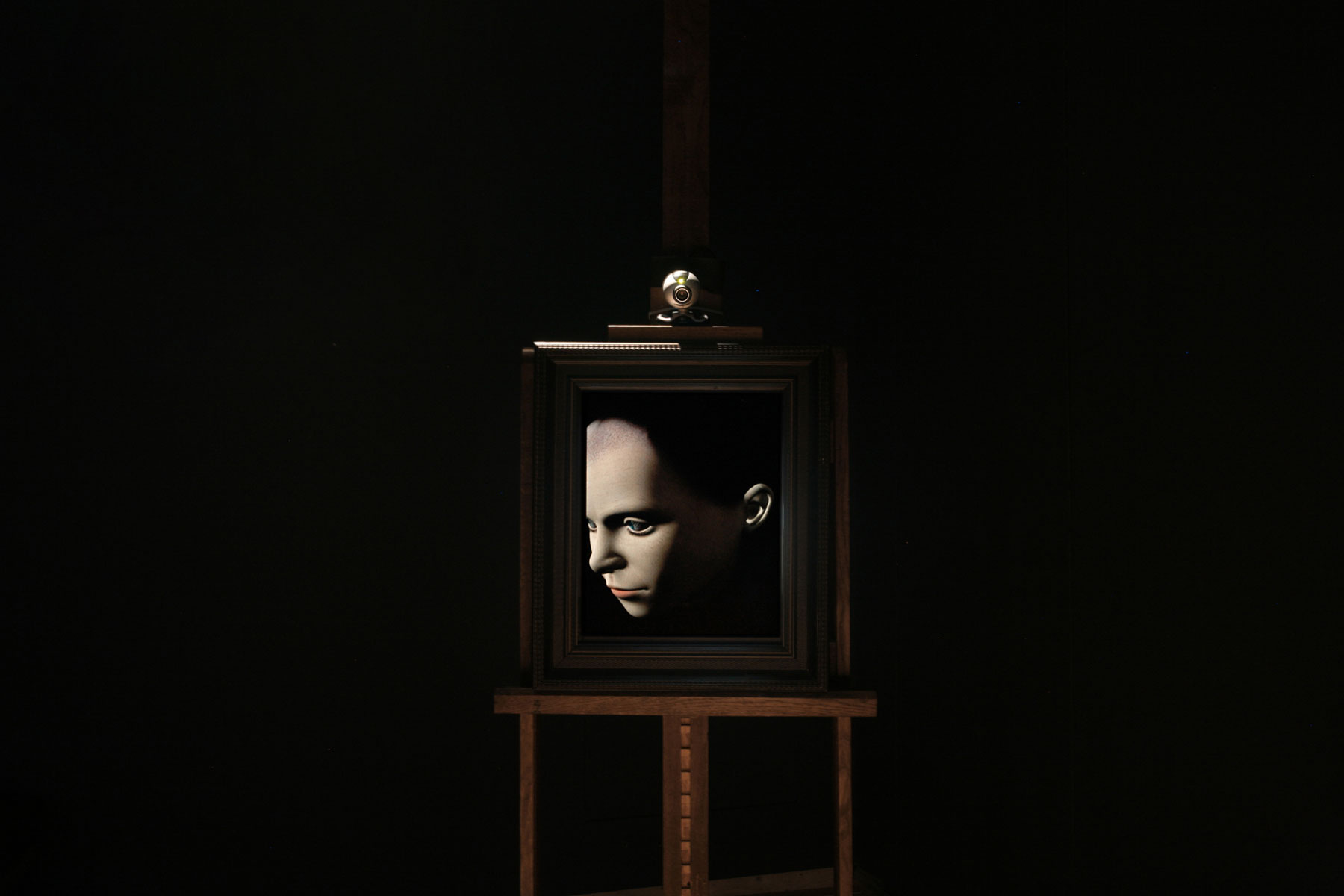
Picture © Catherine Ikam, Louis Fleri, Oscar, 2005
Where is Oscar? The career of a boundary work
2 In this case, the working relationship is one of co-production. The characteristics of the work and the form of the partnership that will be defined have to be at the heart of the production.
Therefore, the virtual actor, Oscar, is at the core of a multi-stakeholder project that should first be described in brief.
next...
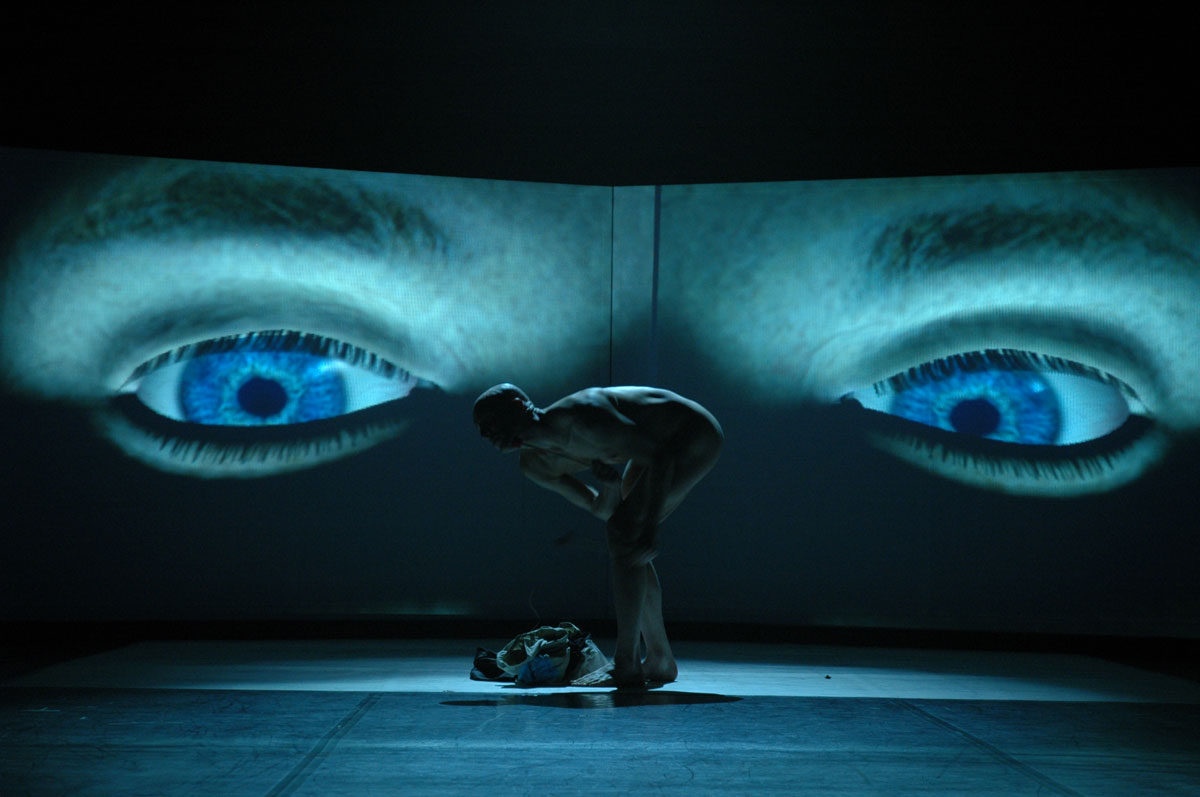
© Roland Auzet, Schlag !, 2003-2017
Scene 1: The Darwin Agency and designing virtual actors
3 Oscar first takes us to Canada, where a team of artists and design researchers from the Université du Québec à Montréal spun off a company designing virtual actors: the Darwin Agency. Here Oscar came into the world, endowed with a design and a virtual personality. As the agency’s first turnkey actor, this prototype already had a basis for facial expression that allowed this creation to express a wide range of emotions. Oscar is one of the potential actors of the Darwin Agency, whose activity lies midway between artistic design and software development and which seeks to commercialise a plug-in – the Darwin selector – among a secure database of tailor-made actors. As Michel Fleury, a designer at the Darwin Agency, tells us: “It’s ‘Artware’, in other words, the artistic dimension is important, but so is the technological dimension […] I call it an inclusive approach. Rather than developing mega software that tries to create virtual actors by itself using its own terminology, I have adopted an approach that is based largely on the artistic approach” (Interview, July 2003).
But Oscar is as yet merely a skeleton – a simple structure that, despite its obvious qualities in terms of functionality, lightness and modularity, is still inanimate. Creating a work of art is not quite the ultimate goal here. But while it has been put on hold, the idea of producing works of art is still important, albeit postponed to a more distant future. Oscar will therefore, thanks to the movement that gives it life, lead the Darwin Agency to innovate by combining new teams of artists and researchers engaged in joint programmes whose goal is to breathe life into a virtual humanity.
next...
Scene 2: ‘Him’ (‘Lui’), or virtual and interactive creation in real-time
4 Next, we follow Oscar to Chalon-sur-Saône, in Burgundy, where artists from the Centre de création en réalité virtuelle (CCRV) join forces with engineers from the Institut Image of the Higher National School of Arts and Crafts (ENSAM) to ensure Oscar could have interactions in real-time. First of all, these engineers give the virtual actor an identity and a role in an immersive and interactive art installation. Renamed “Him” (“Lui”), the actor is granted the ability to receive and translate stimuli from the real world. Integrated into a CAVE (an immersive, three-dimensional virtual environment), it gradually embodies a face-landscape open to the process and to manipulating the public. Thus, it follows on from the various interactive virtual reality installations created by the French artist duo Catherine Ikam and Louis Fléri – L’Autre (1992), Le Messager (1995), Alex (1995) and Elle (1999) – considered successive versions of the same work, at numerous openings and contemporary art festivals linked to new creative technologies.
Oscar also plays a role as a prototype for technological research, allowing these ENSAM researchers to develop and compare their research results, which are usually meant for the automotive or space industry, in a brand-new and original way. Oscar integrates and transforms the field of simulation in its own way, away from the world of the arts, and is praised in particular for its technical dimension during the Nicéphore Days festival in Chalon-sur-Saône, which serves as an international showcase for technological and scientific innovations in the field of new image and sound technologies.
next...
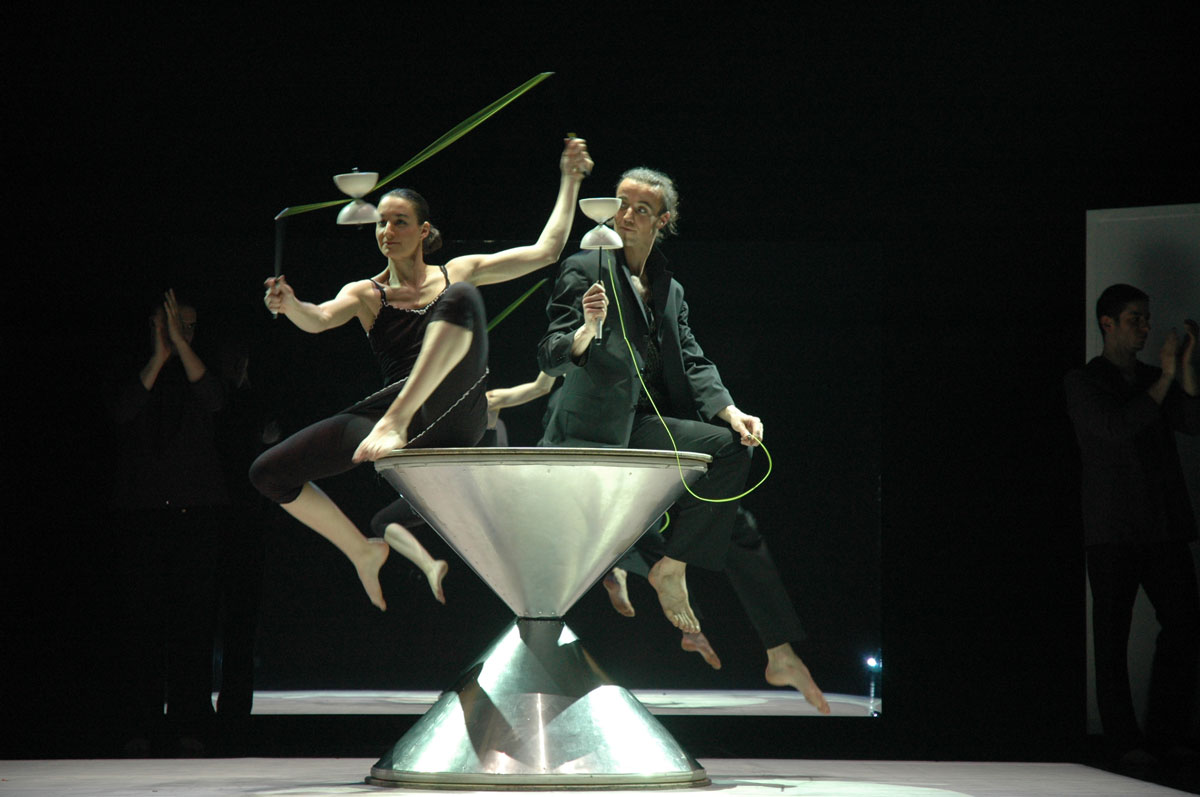
© Roland Auzet, Schlag !, 2003-2017
Scene 3: Schlag!, or musical set design and interactive video
5 The final scene of our triptych takes place in Paris, where the Compagnie Roland Auzet (CRA), hosted by the Institut de Recherche et Coordination acoustique/musique (IRCAM/Centre Pompidou), develops its show, Schlag! The challenge lies in coordinating the computer-assisted musical composition, the multimedia set design and the performance of the actors (both real and virtual, musicians and circus performers) who make up the core of the new creative project. The innovation involves the development of a tool to capture different visual and sound events and how they are staged using pre-existing software (EyesWeb) developed by the computer music laboratory (DIST) at the University of Genoa, Italy. Schlag!, a multimedia circus show, is finally presented in public at the 2003 Agora festival in the City of Paris’s Tuileries Garden. Its main actor, Oscar, is played by the actor “Him”, to whom a new role had been assigned.
Oscar is an actor in his own right responding to the movements of the other actors on stage as captured by three cameras and interpreted by one kind of software
(EyesWeb) that configures his movements and expressions. Another kind of scenography software allows him to be integrated into the real scene and controls (in real-time) his interactions with the other actors, as well as the positioning of the cameras and the screens. A third application is in charge of about 10 lighting moods and alters them in response to the actions of Oscar and the other actors. At the intersection of the performing arts and engineering, Schlag! promotes an interdisciplinary recognition of which IRCAM is both the scientific and the artistic guarantor: the 2003 Résonances festival also offers the opportunity to promote the project’s technological dimension by creating “demos” of the software used in the show.
next...
Different ‘modes of existence’
6 Although the events at which the work was performed varied according to the situations and because of circumstances that are themselves volatile, the path that the work followed was not arbitrary: on the contrary, the many forms that the work takes are isolated by virtue of collective acts of definition. Schlag! demonstrates that the origin of an innovation always has to be sought in a negotiation involving several actors and socio-technical objects. Schlag! is a trade-off between several visions of the project, and mixes heterogeneous personalities who have to come to an arrangement with each other. In the absence of a clear division of labour, reaching a compromise requires the demarcation of different works whose success remains uncertain and potentially asymmetrical. The ways in which the relationship of/to the work is organised is, therefore, part of a qualification-requalification dynamic (of people and of works) conceived as the constant concern of actors who must work together.
next...
Act 1: People’s involvement
7 In this context, far from being a creator in isolation, the artist turns into a small company whose output depends as much on borrowing from others as on his/her own creativity. As digital technology reinforces the adhocratic nature of artistic work, each creation gives rise to a new production function. New contracts must be drawn up to enable the temporary “project-based” organisation and the always prototypical output. This project-based organisation is part of a quality economy where cooperation is built on a pursuit of innovation at each stage of production and is based here on the reputation of the specialist networks. The coordination between them requires that the three scenes comprising the work as a whole be brought together.
The first agreement, which was signed on 17 March and amended on 25 April 2003, regulates the relations between the different partners in scene 3. It imposes the obligation on the CRA and IRCAM to put on 12 shows and a series of six concerts. The agreement also makes it mandatory for this collaboration to be mentioned on all advertising or informational documents.
On 17 April 2003, a second agreement governing the relationship between scenes 1, 2, and 3 was reached. It states that the CCRV had financed and produced, in collaboration with the designers of the Darwin Agency, a virtual reality character “imagined and created by Catherine Ikam and Louis Fléri.”
Finally, on 15 May 2003, the third and final “co-production contract” was signed to coordinate between the creators of scenes 2 and 3. In it, the “authors” of the virtual actor (Catherine Ikam and Louis Fléri) grant non-exclusive authorisation to have Oscar perform on stage as part of the French productions of Schlag! In other words, they “authorise” the CRA to use their virtual actor “for a limited period of time in the paid Schlag! Performances.” It is in this regard that the “contractual” innovation is at its most radical and wholly unprecedented: “every evening, Oscar, a digital creature but a fully fledged actor, will have to be paid like any other actor in the troupe.” That means the CRA is obliged to pay Oscar (rather, his creators) an actor’s fee for each of Oscar’s performances in the circus tent.
In this regard, our investigation presents an analysis going beyond the notion of a “collective work”, which has been well identified by the art world. However, although this notion is based on multiple contributions, it does not always help in identifying the singularity of the different contributions – one in which a hegemonic author often predominates – as shown by the convention of having credits in a performing arts work. On the contrary, the goal here is to tease out the wellsprings of a creation that is not merely collective but interdisciplinary, which thwarts the conventional and standardised forms of assignment and authority within the worlds of art.
next...
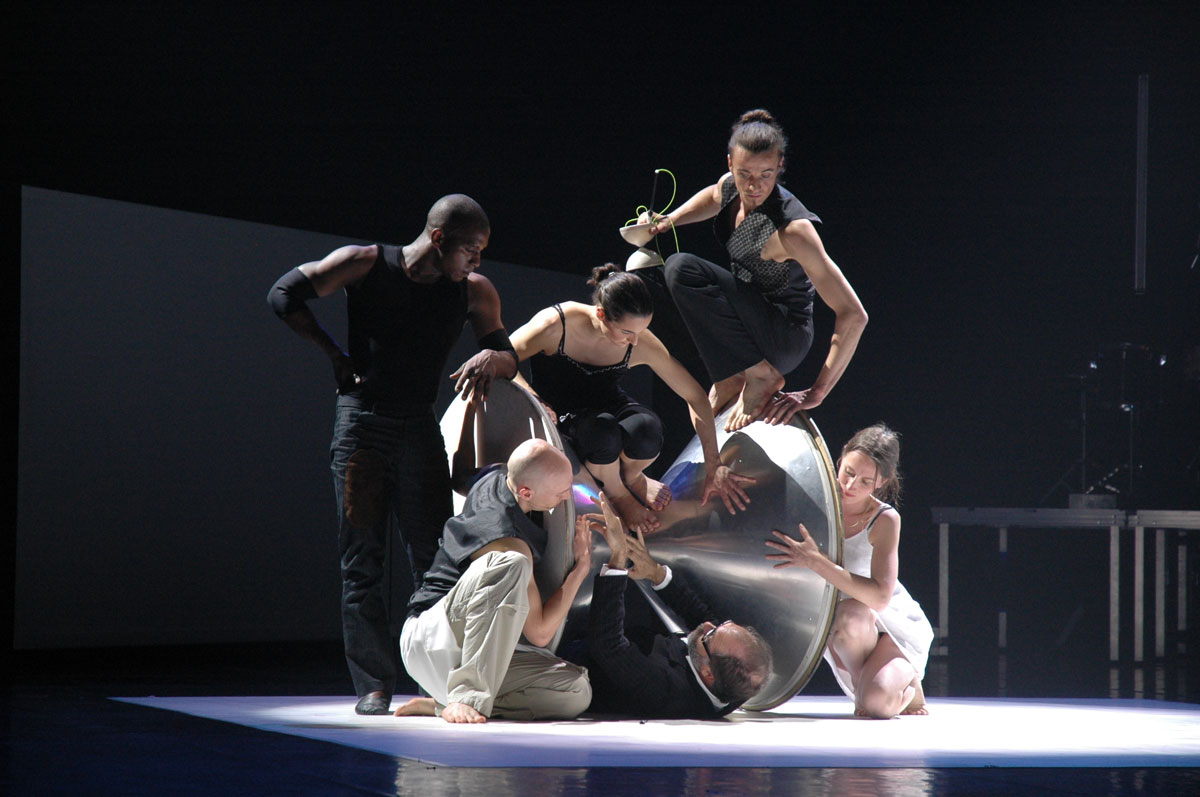
© Roland Auzet, Schlag !, 2003-2017
Act 2: The classification of works
8As a result, classifying works becomes an explicit challenge for all the creators involved. But as Schlag! shows, there is not just one but several “markets” in which this production is disseminated. Thus, the dynamics of co-production in digital art moves us from artistic work directed at the production of an art object towards a transversal creative programme with several teams dealing with fragmented and multi-centric works.
Thus, we should consider the work of art from the point of view of its dissemination, in line with Callon, Maedel, and Rabeharisoa, who propose naming this dynamic product economy an “economy of qualities." According to them, “the product [...] is an economic good considered in terms of how it is manufactured, disseminated and consumed. The notion (producere: to move forward) emphasises that it consists of a sequence of actions in a string of operations that transform it, move it and pass it on from one hand to the next through a series of metamorphoses that end up giving it a form considered useful by an economic agent who pays in order to benefit from it. During these metamorphoses, its characteristics change.”
This point of view has several implications for the traditional definition of a work of art, and these implications vary much more than is provided for in the intellectual property law relating to collective works. In Article L 113-2 of the French Intellectual Property Code, a “collective work” is generically referred to as an intellectual work created at the initiative of a natural or legal person who edits it, publishes it, and discloses it under his direction and name and in which the personal contributions of the various authors who participated in its production are merged in the overall work for which they were conceived, without it being possible to attribute to each author a separate right in the work as created.
However, the same article in the law introduces an interesting clarification with its definition of a “work of collaboration”, which makes it possible to specify and identify the status of contributions with greater specificity: a divisible work of collaboration introduces the possibility of identifying the contributions made by different persons to the collective work, while an indivisible work of collaboration does not allow the different contributors to be identified as distinct participants. Nevertheless, none of these three types of work (collective, divisible, or indivisible work of collaboration) identified and described in Article L 113-2 of the Intellectual Property Code provide for the possibility of granting each of the persons who contributed to the common work a separate right over the whole.
And yet, our examination of the Schlag! case shows that the common work manages to move beyond the tension of its collective production thanks to many social fixations. By monitoring its transformations, our sociology of artistic work enables us to shed light on the theatre of operations and negotiations embodied in and executed by the work: negotiations between actors and objects with respect to roles or identities in the negotiated order between the various social worlds in which this work is disseminated. Because of its instability and its plastic nature, this “boundary work” eludes the usual definitions of art and adapts to the specific needs and necessities of the different actors with whom it engages. At the same time, however, it must remain robust enough to preserve the common project and the identity of these different actors.
next...
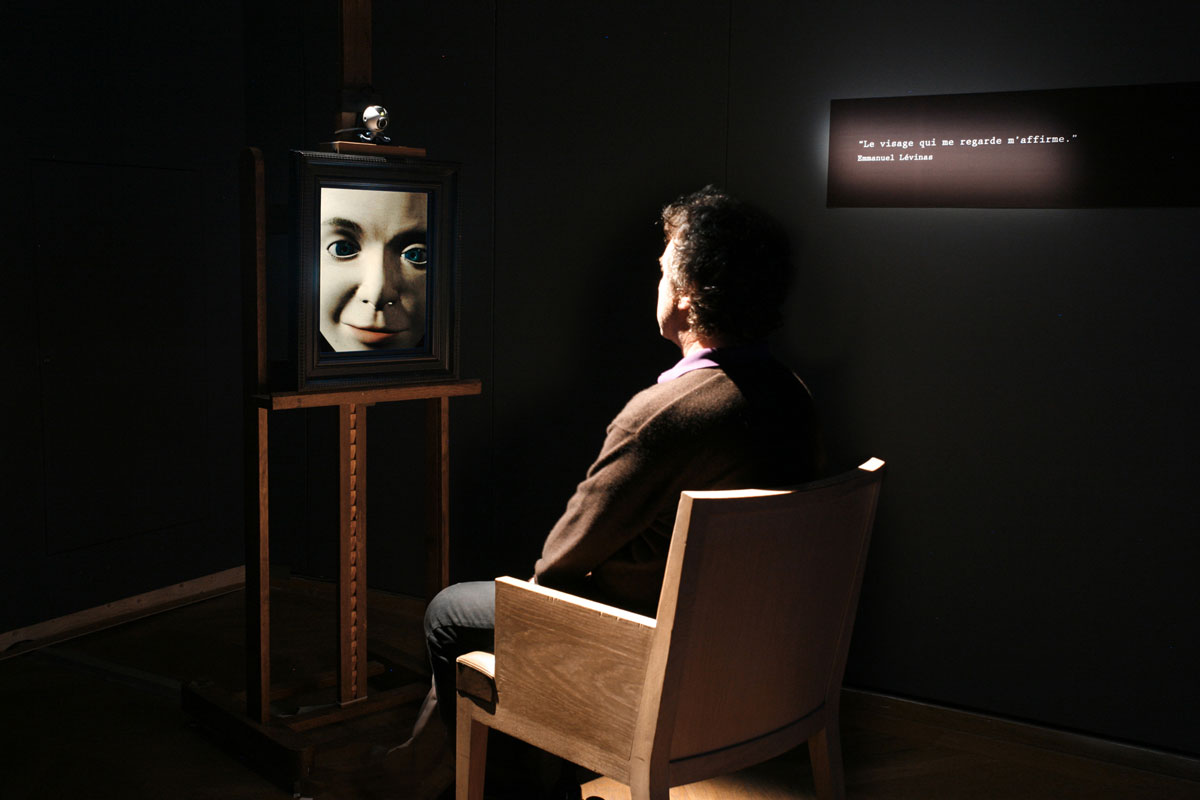
© Catherine Ikam, Louis Fleri, Oscar, 2005.
Conclusion
9 For the past decade, digital technology has blurred the lines separating fields of artistic activity that had previously been relatively compartmentalised: visual arts, literature, performing arts, music, and the audio-visual arts. Many artistic projects related to computer and multimedia technologies have implemented multidisciplinary partnerships in which theatre, dance, cinema, or video and sound co-exist. Their design involves various artistic and computer contributions that establish a fragmentation of creative activity and multiple methods for designating what a work of art will be. These changes in artistic creation and technological research were once clearly separate and almost impermeable fields but are now so intertwined that any innovation within one is of interest to (and influences) the development of another. The hybrid works that result from their interpenetration make the blurring of former boundaries between art and science irreversible. Moreover, the unprecedented way in which these boundaries are reconfigured raises questions both about the interconnection that now allows research and creation to interact with each other and about the ways in which works are classified and assessed.
As sociologist Raymonde Moulin indicated, when artistic and technical objects become practically indistinguishable from each other as a result of their manufacturing conditions, their ultimate difference lies in the purpose for which they are intended. In this regard, the artistic work changes in scale and in nature. More collective and interdisciplinary, it is underpinned by the marketing of hybrid products: works of art, software solutions and technical processes. The monitoring of a research-creation case in the digital arts and technologies sheds light on these production logics targeting a variety of exhibition (artistic and scientific), invention (technological) and innovation (economic) issues. Two major innovations are introduced: interdisciplinary teamwork and the need for a research programme encompassing several works or projects.
The sociological analysis of Schlag! puts into perspective these heterogeneous stories and social scenes in which there is a reconfiguration of the boundaries of artistic activity: those of both the work and the product, as well as those of the hybridisation of artistic and technological skills. Detailed arrangements make it possible to redistribute the purposes of the common work according to its interest and the tactics appropriate to the demand and the multiple contexts of valorisation. But they also have to make it possible for each of the partners to cross-fertilise contributions and credit in different social worlds. Away from a conception that is too unitary and closed, the work becomes more versatile and can be moulded in different ways according to the (scientific or artistic) market for which it is intended. Thus, the promotional activity makes it possible to identify different research-creation externalities and to change when and where they are exhibited or marketed.
Since the very first performance of Schlag!, which was the starting point for this investigation, many other projects have focused on the virtual actor whose origin and development we have described here.
In the field of performing arts, Roland Auzet himself created a follow-up to his first show, named Oscar, Pièce de cirque (Schlag 2), in 2005, in collaboration with the Geneva Percussion Center. In 2013, this virtual actor also appeared in a new production by Fabrice Melquiot and Roland Auzet, entitled Aucun homme n’est une île, which would later be revived between 2015 and 2016. It was an intimate theatre show for two actors, including Oscar, aimed at a younger audience.
In the field of visual and installation arts, Oscar appeared in a series of creations of which Catherine Ikam and Louis Fléry were the driving forces: in particular, an exhibition at the Albert Benamou Gallery in Paris, entitled “Digital Humans”, in 2008; an extension of the project entitled Faces, presented at the International Digital Arts Biennale in Enghien-les-Bains, in 2014; and an installation that formed part of the “Artists and robots” exhibition at the Grand Palais in Paris in 2018.
On each occasion, a new credits sequence is created in order to alternate the distribution of the names of the authors. In the meantime, thanks to the Bologna agreements, the notion of art research has gained ground, and there has been an increase in the number of opportunities for collaboration between art and science, although the ways in which the “results” of these research-creations are used and assigned are not always explored in a truly original manner. While adaptation is necessary and takes shape only gradually, the inertia of the social worlds still tends to reify and isolate artistic creations from scientific creations. The frequent choice to remove a scientific researcher’s name when works are valued by and in the art world is a clear symptom of the persistence of this inertia.
In this context, while it is still difficult to keep the mandate of a production that competes with industrial Research and Development or to satisfy the production of a work of art as it could be defined for more traditional media, new forms of production are emerging beyond this categorical opposition; although not purely applied or free, they do create new areas of hybridisation between art, science, and technology.
next...
Notes
10
1. Résonances Festival (2003), Institut de recherche et coordination Acoustique-Musique (IRCAM), Centre Georges-Pompidou (Beaubourg): http://agora2003.ircam.fr. Volker Schlöndorff’s film, The Tin Drum, is adapted from Günter Grass’s novel of the same name.Le Tambour, Gallimard, 1961.
2. For a more comprehensive and detailed analysis, see Fourmentraux, Jean-Paul, 2006, “Internet artwork, artists and computer programmer: sharing the creative process”, Leonardo, MIT Press, 39(1), 44–50.
3. In this context, a socio-anthropology of works in no way implies only being interested in works as already constituted objects; on the contrary, its heuristic derives from a “postponement of the results and purposes.” Cf. Abbott, Andrew, 2001, Time and Matters. On Theory and Method, University of Chicago Press, Chicago. Fabiani, Jean-Louis, 2003, “Pour en finir avec la réalité unilinéaire. Le parcours méthodologique de Andrew Abbott”, Annales HSS, no. 3, pp. 549–565.
4. According to the philosophy of pragmatist aesthetics: see Souriau, Etienne, 1956, “L’œuvre à faire”, Bulletin de la Société française de philosophie, Lecture on 25 February. Souriau, Etienne, 2009, Les différents modes d'existence. Followed by L’œuvre à faire (with an introduction, “Le sphinx de l’œuvre”, by Isabelle Stengers and Bruno Latour), Paris, PUF.
5. The concept of “career” should be understood first and foremost as the interactionists intended: cf. Becker, Howard, 1986, Outsiders, Métailié, Paris. Becker, Howard, 1988, Les Mondes de l’art, Flammarion, Paris. At the very least, it should be viewed in the sense that was later given to it by economic anthropology, which focused more on objects captured through their successive systems of qualification and valuation: Appaduraï, Arjun, 1986, The Social Life of Things. Commodities in Cultural Perspective, Cambridge University Press, Cambridge; Kopytoff, Igor, 1986, “The Cultural Biography of Things: Commoditization as Process”, in Arjun Appaduraï (ed.), The Social Life of Things. Commodities in Cultural Perspective, Cambridge University Press, Cambridge.
6. Cf. Latour, Bruno, Weibel, Peter, 2005, Making Things Public: Atmosphere of Democracy, MIT Press, London.
7. Not unlike Star and Griesemer’s notion of a “boundary object”, which describes an entity that serves as an interface between social worlds and actors with different perspectives. According to Star and Griesemer, a boundary object is “plastic enough to adapt to the local needs and constraints of the several parties employing them, yet robust enough to maintain a common identity across sites” (1989, p. 393). The boundary object can be concrete or abstract, exist simultaneously in several social worlds and still “satisfy the informational requirements of each of them”. See Star, Susan Leigh, Susan Leigh, Griesemer, James, 1989, “Institutional Ecology, ‘Translations’ and Boundary Objects: Amateurs and Professionals in Berkeley’s Museum of Vertebrate Zoology, 1907-39”, Social Studies of Science, no. 19, pp. 387–420; see also Fujimura, John, 1990, “Crafting Science: Standardized Packages, Boundary Objects, and Translation”, in Bijker, Hugues, & Pinch, The Social Construction of Technological Systems: New Direction in the Sociology and History of Technology, Cambridge: MIT Press, pp. 168–211.
8. For a description of the innovations at the artistic level, see Catherine Ikam and Louis Fléri, “Identité et réalité virtuelle : l’interaction en temps réel avec des acteurs virtuels dans un contexte muséal et comme élément d’un spectacle vivant”, Hybrid Reality: Art, Technology and the Human Factor, Montreal, Quebec, Canada, October 2003, 15–17, pp. 659–668.
9. In a context of unstable and complex environments, adhocracy (from the term “ad hoc”) refers to an organisational configuration that mobilises multidisciplinary, specialised, and transversal skills to carry out very specific missions (e.g. problem solving, seeking efficiency in management, developing a new product...). The people chosen inside the organisation work in poorly formalised project groups that have considerable autonomy from the procedures and hierarchical relations normally in effect and whose main mechanism for coordination between operators is mutual adjustment.
10. As follows: “A Site Cra, Ircam (Centre Pompidou) co-production. Software developed at the Ircam studios. Music assistants: Frédéric Voisin, Manuel Poletti. Design engineers: Emmanuel Fléty (Ircam), Yan Philippe (Site Cra).”
11. Any visual and/or audio advertising requires the following statement: “creation of the virtual character and video images: Catherine Ikam and Louis Fléri. Creation and development of the real-time virtual character: Centre de Création en Réalité Virtuelle, in collaboration with the Institut Image/ENSAM de Chalon-sur-Saône. Software engineers: Julien Roger, Jean-Michel Sanchez, Thomas Müller, Emmanuel Fournier, Olivier Prat and the Darwin Agency (UQAM). Modelling, textures: Michel Fleury, Solange Rousseau, Jean-François Blondin.”
12. Callon, Michel, Meadel, Cécile, Rabeharisoa, Volona, 2000, “L’économie des qualités”, Politix, 52, 1, 211–239.
13. Cf. http://www.legifrance.gouv.fr/.
14. Cf. Strauss, Anselm, 1992, La Trame de la négociation, L’Harmattan, Paris.
15. Cf. Callon, Michel, Meadel, Cécile, Rabeharisoa, Volona, 2000, “L’économie des qualités”, Politix, 52, 1, 211–239. Callon, Michel, Lascoumes, Pierre, Barthes, Yannick, 2001, Agir dans un monde incertain, Seuil, Paris.
16. Moulin, Raymonde, 1969, “Art et société industrielle capitaliste. L’un et le multiple”. Revue française de sociologie 10, 687–702.
> Back to top of article...
http://www.antiatlas-journal.net/pdf/03-Fourmentraux-boundary-works-art-science-technology.pdf


